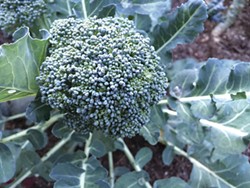[
{
"name": "Top Stories Video Pair",
"insertPoint": "7",
"component": "17087298",
"parentWrapperClass": "fdn-ads-inline-content-block",
"requiredCountToDisplay": "1"
}
]
Broccoli is one of those crops that a lot of us have trouble with. Sometimes you get a great head, sweet and delicious. Other times you get a bunch of bolted shoots covered in aphids. So what's the trick? Broccoli has some special needs, and a basic understanding of what to do, and what not to do will make a big difference in how well your crop turns out. Here's the rundown:
Do:
Choose a reliable variety for your area. In Humboldt, most of the Romanesco varieties do well. Also try Calabrese green sprouting, early purple sprouting or Waltham. All of these are available through Baker Creek Seed Company, which specializes in varieties for our region.
Start your seeds early. Anytime between late February and mid-April is a great time to start broccoli from seed. Sow in a flat under a cold frame, in a sunny window indoors, or directly into the garden.
Make sure you are planting starts in good soil. Broccoli needs well-drained soil with a good balance of sand and loam. Your pH is also important, and should be between 5.8 and 6.5 for best results.
Give baby plants more than enough room to grow. A lot of seed packets say to plant broccoli 18 inches apart but I find that a spacing of 3 feet is much better. Air circulation is very important, so keep the beds weeded and don't allow any other plants to crowd out your broccoli.
Water evenly and intentionally. Try to stick to a regulated watering schedule. If you let them dry out too much, the plants will likely get covered in aphids. If you water too often, or too much at once, they will turn yellow and mold.
Fertilize. Broccoli is a heavy feeder. Amend the soil with a good 5-10-10 organic fertilizer, or use your richest, blackest home-made compost, before transplanting the starts into it. When the heads are just starting to form, fertilize again.
Be meticulous about slugs and snails. Mollusks especially love baby brassicas! Don't give them a chance to eat your plants. See my article on natural slug and snail controls ("Happy Trails," Dec. 24, 2015).)
Grow cauliflower too. I don't know why, but cauliflower is much less likely to bolt and be problematic than broccoli. This is especially true if you have marginal soil or if your garden gets a lot of direct sun. Most cauliflower varieties take much longer to mature than broccoli, but the heads can get huge and the flavors and nutrients are quite similar.
Don't:
Try to grow broccoli in the hot season. Broccoli is for spring and fall only. If you try to grow it when the weather is too hot, you probably will not have much success.
Get greedy. If your plant has a nice head on it, harvest it. Keep watering and you will probably get some smaller shoots to eat later on. But that head will most likely not get bigger if you wait. Once the head is basically formed, the plant wants to bloom, and your flavor will get more bitter and astringent from there.
Neglect young seedlings. Don't let the baby seedlings get too hot and don't let them get too big before you plant them. Any stress, especially getting root-bound in the starter pots, will cause your broccoli to bolt early.
Transplant carelessly. Don't transplant seedlings too shallow in the garden. I bury them right up to their necks, so that the cotyledons are underground and the first true leaves are just above the soil surface. Tamp the soil down around the transplants so they are firmly held in place and won't get disturbed by heavy rain or watering.
Bring in tough competition. Don't plant any other brassicas anywhere nearby. Also don't plant broccoli next to Nightshades like tomatoes or potatoes. They don't grow well together. Try beets, onions and garlic instead.
Grow brassicas in the same spot every year. Cabbage worms, one of the worst pests for brassicas, lay their eggs in the soil below your plants. Make sure to rotate your broccoli crop into a new area each year, an area where you haven't grown broccoli, kale, cabbage or any other brassicas for at least the two years prior. For best results, plant broccoli in a spot where you had cover crops the year before.
OK, that's it! Follow these simple guidelines and you'll have the most beautiful broccoli you've ever grown, I promise.
Comments (3)
Showing 1-3 of 3
more from the author
-
Tales from the Underground
A rainbow of roots from around the world
- Sep 21, 2017
-
Hashtag, Bumper Crop
Veggies to plant now for fall and winter
- Aug 17, 2017
-
Plotting Out Your Garden: Part 2
- Apr 6, 2017
- More »

































